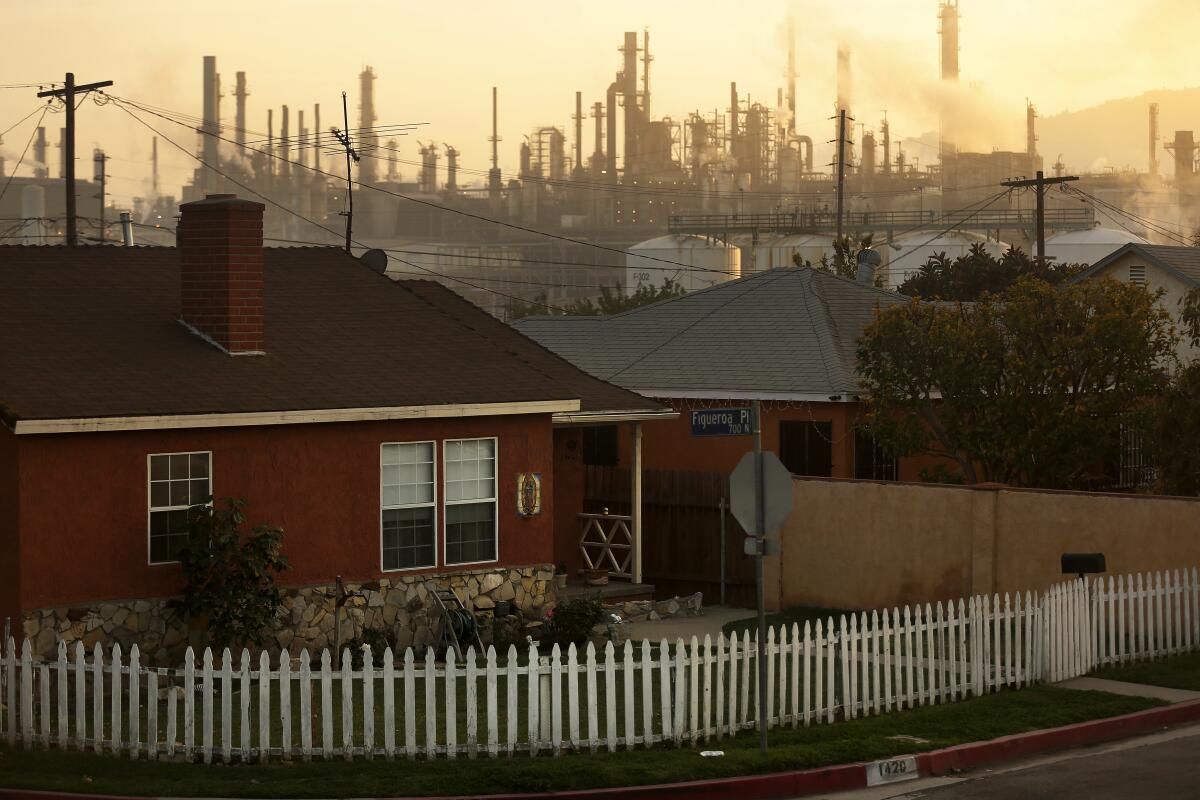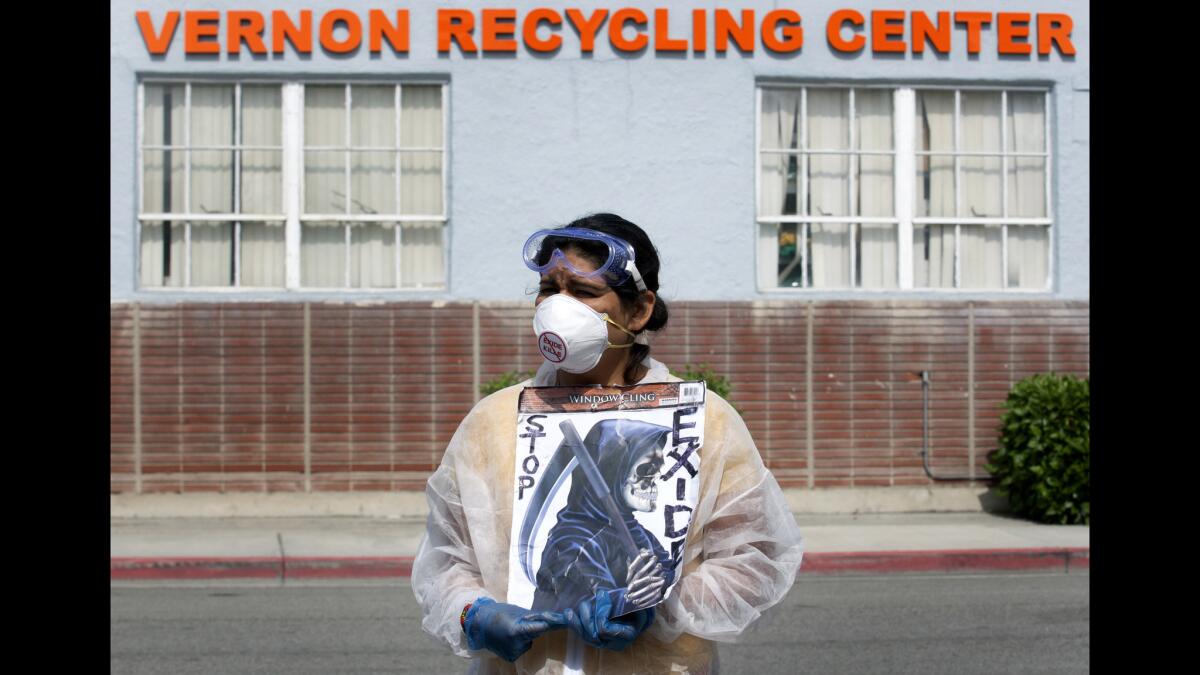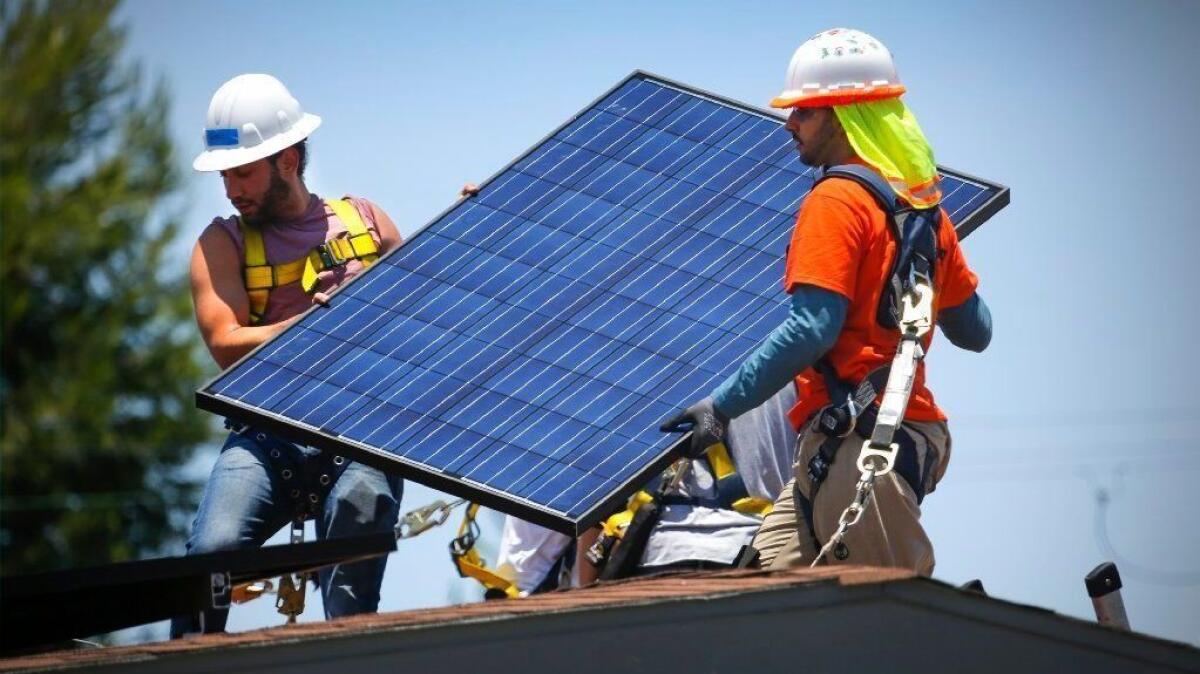Why communities fighting for fair policing also demand environmental justice
Welcome back to Boiling Point, a newsletter about climate change and the environment. I’m Sammy Roth.
There were several topics I considered writing about this week, including the results of California’s latest cap-and-trade auction and a bill in Sacramento dealing with the proposed Eagle Mountain hydropower project.
But after a week of protests following the death of George Floyd at the hands of police, I realized there was only one topic I could focus on in this newsletter: environmental injustice. It’s a term that describes how people of color and poor communities have borne disproportionate harm from pollution, and the discriminatory systems that have perpetuated those inequities.
Toward a more sustainable California
Get Boiling Point, our newsletter exploring climate change, energy and the environment, and become part of the conversation — and the solution.
You may occasionally receive promotional content from the Los Angeles Times.
There are countless links between environmental degradation and inequality. Consider water contamination in predominantly black and brown communities, such as Flint, Mich., where experts say the drinking water crisis was rooted in systemic racism. Or research finding that, in the U.S., the best predictor of whether you live near a hazardous waste site is the color of your skin.
In Los Angeles, poisonous lead contamination at homes near the closed Exide battery recycling plant has yet to be fully cleaned up, hurting working-class Latino families, as my colleague Tony Barboza has reported. Black, Latino and low-income California residents are especially likely to live near unplugged oil and gas wells that can spew pollution, a Los Angeles Times investigation found. People of color are more likely than white people to live alongside power plants, oil refineries and landfills.
Rachel Ramirez discussed the roots of environmental injustice in a piece for Grist this week, noting that “some legacies of redlining — the government-sanctioned denial of home loans and insurance to communities of color — include housing stock that is disproportionately located near polluting industrial infrastructure.”

The COVID-19 pandemic has only worsened existing inequities.
In a story for Outside magazine, Heather Hansman explains how a lack of access to clean drinking water in the Navajo Nation has helped fuel the country’s worst known COVID-19 outbreak by infection rate. My colleague Kurtis Lee has also written several pieces about the Navajo Nation’s unique vulnerability to the coronavirus, as well as its lack of running water and electricity.
There’s already research linking polluted air — which, in America, blacks and Latinos are more likely to breathe — with a higher likelihood of dying from COVID-19.
Marshall Shepherd, a climate scientist and former president of the American Meteorological Society, wrote that “I can’t breathe” — some of the last words spoken by George Floyd as a police officer pressed a knee into his neck — seems like a theme for 2020.
“The historic coronavirus pandemic has literally taken the breath of many people,” Shepherd wrote in a piece for Forbes.
Then there’s global warming.
The climate crisis often hits people of color hardest, in the U.S. and around the world. It’s true in cities, where black, brown and low-income people experience hotter temperatures during deadly heat waves because their neighborhoods lack tree cover and parks, or because they’re near freeways or industrial facilities. It’s true in Puerto Rico, where Hurricane Maria caused thousands of deaths and gave birth to a climate movement. It’s true in Central America, where climate-fueled drought is driving migration.

Writing for the Guardian a few years ago, Black Lives Matter co-founder Patrisse Cullors and fellow activist Nyeusi Nguvu argued that “the inequalities that turn an extreme weather event into a disaster or human catastrophe mirror the inequalities that cause the disproportionate loss of black and poor life globally — and the exact systems that Black Lives Matter fights against.”
“Environmental injustice has always been an issue and a fight taken on by black and poor communities,” they wrote. “We are the first to die, but we are also the first to fight on the frontlines.”
Those ideas help explain why a growing number of activists support policy proposals, such as the Green New Deal, that tie climate change action to significant economic reforms meant to tackle inequality and racism.
Or as many folks have put it on Twitter: “Climate justice is racial justice.”
At the same time, racism can derail efforts to fight climate change, according to the marine biologist Ayana Elizabeth Johnson.
“How can we expect black Americans to focus on climate when we are so at risk on our streets, in our communities, and even within our own homes?” Johnson asks in an op-ed for the Washington Post.”How can people of color effectively lead their communities on climate solutions when faced with pervasive and life-shortening racism?”
As a journalist, I don’t pretend to have the answers. But I know it’s incumbent on me to be part of the conversation, and to shine a light on environmental injustice. So consider this week’s newsletter my commitment to doing more. Hold me accountable, please.
Here’s what else is happening around California and the American West:
TOP STORIES
For the first time since 1885, the U.S. got more energy from renewables than from coal in 2019. This was going to happen sooner or later, as solar and wind power are increasingly beating coal on cost. But it’s still a huge milestone; here’s the story from Katherine Blunt at the Wall Street Journal. Coal’s decline has continued in 2020, with 13 plant closures announced this year, per Benjamin Storrow at E&E News. (For a slightly out-of-date look at coal closures in the West, here’s a story I wrote in February.)
In a landmark vote, a majority of Chevron shareholders demanded that the oil giant issue a report on its climate change lobbying. The shareholder resolution is nonbinding, as Los Angeles Times columnist Michael Hiltzik explains in his piece. But it’s the latest sign that investors want to know how oil and gas companies plan to keep making money in a climate-constrained world.
Probably my favorite read this week was “Cash Flows: How Investors Are Banking On the West’s Water Scarcity.” It’s a collaboration between public radio stations and other nonprofit news outlets in Arizona, Colorado and Nevada, tracking how out-of-town private investors are buying up farmland in hopes of selling rural water supplies to cities, or otherwise transferring water from agriculture to other uses. The fear of water transfers is also pervasive in California’s Imperial County, as I wrote in April.
POLITICAL CLIMATE
Can a new climate consensus unite the left and boost Joe Biden? In two pieces for Vox, David Roberts makes the case that after years of disagreement between various left-of-center factions on climate change, there’s an emerging policy consensus focused on sector-specific standards, public investments and a commitment to justice. Roberts also argues that embracing this consensus would help Joe Biden build support among climate activists, environmental justice advocates, unions and other key groups.
The tracks do not appear to be greased for quick construction of high-speed rail in California. Twelve years after voters approved bonds to build a bullet train from Los Angeles to San Francisco, environmental impact statements are still trickling in. The latest one focuses on a 14-mile segment from downtown L.A. to Burbank, as Ralph Vartabedian writes for The Times. Ralph also reports that the bullet train may need operating subsidies, contrary to what voters were once promised.
Environmental activists are pushing back against Gavin Newsom’s budget proposal. With California facing a projected $54-billion budget shortfall amid the coronavirus crisis (remember the coronavirus?), Gov. Newsom has taken a sledgehammer to all sorts of climate and environmental priorities, proposing less spending — relative to his earlier budget plan — on electric vehicle rebates, oil and gas regulation and preserving wildlife habitats, as Dustin Gardiner reports for the San Francisco Chronicle.
Enjoying this newsletter? Consider subscribing to The Times
Your support helps us deliver the news that matters most, and makes newsletters like Boiling Point possible. Become a Los Angeles Times subscriber.
POWER STRUGGLES
The electric truck start-up Nikola is about to go public. Here’s the story by Russ Mitchell for The Times. If you’ve never heard of Nikola, there are a few things to know: Like Tesla, the company is named for electric grid pioneer Nikola Tesla; and unlike Tesla, the company’s founder has only nice things to say about his competitor, Elon Musk. (Also unlike Tesla, Nikola plans to use hydrogen fuel cell technology rather than lithium-ion batteries. I’ve written about hydrogen a few times recently; see here and here.)
Let’s call it a tale of two San Diegos. A new report finds that L.A.’s neighbor to the south has the second-most solar power of any U.S. city, as the San Diego Union-Tribune’s Rob Nikolewski reports. (Los Angeles came in first, although San Diego has more solar per capita.) But what about transportation, the largest source of climate pollution? David Garrick reports that some San Diegans are unhappy about a plan to spend suburban development fees building bike lines and bus routes in denser neighborhoods.

AROUND THE WEST
Federal judges are pushing back against President Trump’s fossil fuel agenda. It’s been a rough few months for the Trump administration’s efforts to open up more of the West’s public lands to oil and gas drilling: Federal judges have canceled fossil fuel leases across more than 300,000 acres in Montana and Wyoming, rejected plans for new natural gas wells in Colorado, and once again blocked construction of the Keystone XL oil sands pipeline, as Matthew Brown reports in an Associated Press roundup.
The Klamath Basin is facing a severe water shortage. It’s worth remembering that in a state as big as California, drought can be a regional phenomenon. So even though Southern California has gotten a good amount of rain the last few months, the state’s far northern region is still quite dry — which is why the U.S. Bureau of Reclamation told farmers along the Oregon border to plan for a lot less water than normal, then cut their estimates even further, as the San Francisco Chronicle’s Kurtis Alexander reports.
Here’s an absolutely wild story. As oil and gas drillers fight Colorado’s growing push to regulate them, a University of Colorado scientist who has been monitoring emissions from fracking operations was abruptly fired by the university, as Daniel Glick reports for InsideClimate News. The school claimed he misused public funds, but Glick uncovered several holes in that explanation.
What do you want to know?
When you think about California’s climate future, what comes to mind? What keeps you up at night, and what gives you hope or gets you excited? What do you want to understand, and what should I?
This newsletter is for you, to help you understand how we’re changing our world and what we can do about it, and I want to hear your questions, concerns and ideas. Email me or find me on Twitter.
ONE MORE THING
It’s been a heavy week, to say the least, so I’ll end with something light and fun.
People have been telling me for years to watch “California’s Gold,” a public television program hosted by the late Huell Howser that explored “the state’s rich history, cultural diversity, landmarks, natural wonders, amazing people and points of interest, especially lesser known and out-of-the-way places,” per IMDb. I’d never seen an episode until this weekend, when I watched Huell’s visit to one of my favorite places in the world, Mt. San Jacinto outside Palm Springs.
The episode focuses on two things: the Palm Springs Aerial Tramway, an amazing contraption that carries visitors nearly 6,000 feet up the mountain in little more than 10 minutes; and the Colorado River Aqueduct, which bores a tunnel through the mountain on its path to deliver water from the California-Arizona border to the Los Angeles area. Huell actually gets a look inside the tunnel!
Anyway, the episode is an absolute treat. I’m looking forward to watching more “California’s Gold” at the show’s archives.
I’ll be back in your inbox next week. If you enjoyed this newsletter, please consider forwarding it to your friends and colleagues.




